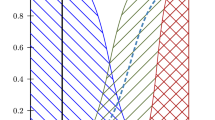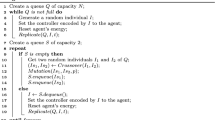Abstract
The accumulation of adaptations in an open-ended manner during lifetime learning is a holy grail in reinforcement learning, intrinsic motivation, artificial curiosity, and developmental robotics. We present a design for a cognitive architecture that is capable of specifying an unlimited range of behaviors. We then give examples of how it can stochastically explore an interesting space of adjacent possible behaviors. There are two main novelties; the first is a proper definition of the fitness of self-generated games such that interesting games are expected to evolve. The second is a modular and evolvable behavior language that has systematicity, productivity, and compositionality, i.e. it is a physical symbol system. A part of the architecture has already been implemented on a humanoid robot.
Access this chapter
Tax calculation will be finalised at checkout
Purchases are for personal use only
Preview
Unable to display preview. Download preview PDF.
Similar content being viewed by others
References
Bellas, F., Duro, R., Faina, A., Souto, D.: Multilevel darwinist brain (mdb): Artificial evolution in a cognitive architecture for real robots. IEEE Transactions on Autonomous Mental Development 2(4), 340–354 (2010)
Fisher, R.: The Genetical Theory of Natural Selection. Clarendon Press (1930)
Rechenberg, I.: Evolutionstrategie 94. Frommann-Holzboog, Stuttgart (1994)
Bongard, J., Lipson, H.: Nonlinear system identification using coevolution of models and tests. IEEE Transactions on Evolutionary Computation 8(4), 361–384 (2005)
Baranes, A., Oudeyer, P.Y.: R-iac: Robust intrinsically motivated active learning. In: 2009 IEEE 8th International Conference on Development and Learning, Shanghai, China, pp. 1–6 (2009)
Baranes, A., Oudeyer, P.Y.: Intrinsically motivated goal exploration for active motor learning in robots: a case study (2010)
Baranes, A., Oudeyer, P.Y.: Active learning of inverse models with intrinsically motivated goal exploration in robots. Robotics and Autonomous Systems (2012)
Oudeyer, P.Y., Kaplan, F., Hafner, V.: Intrinsic motivation systems for autonomoys mental development. IEEE Transactions on Evolutionary Computation 11(2), 265–286 (2007)
Fodor, J., Pylyshyn, Z.: Connectionism and cognitive architecture: A critical analysis. Cognition 28, 3–71 (1988)
Hofstadter, D., Mitchell, M.: The copycat project: A model of mental fluidity and analogy-making. In: Fluid Concepts and Creative Analogies: Computer Models of the Fundamental Mechanisms of Thought, pp. 205–267. Basic Books, New York (1995)
Newell, A.: Unified Theories of Cognition. Harvard University Press (1990)
Anderson, J.: How Can the Human Mind Occur in the Physical Universe. Oxford University Press (2007)
Sun, R.: Duality of the Mind: A Bottom-up Approach Toward Cognition. Lawrence Erlbaum Associates, Mahwah (2002)
Marcus, G.: The Algebraic Mind: Integrating Connectionism and Cognitive Science. MIT Press (2001)
Author information
Authors and Affiliations
Editor information
Editors and Affiliations
Rights and permissions
Copyright information
© 2013 Springer-Verlag Berlin Heidelberg
About this paper
Cite this paper
Fernando, C., Vasas, V., Churchill, A.W. (2013). Design for a Darwinian Brain: Part 2. Cognitive Architecture. In: Lepora, N.F., Mura, A., Krapp, H.G., Verschure, P.F.M.J., Prescott, T.J. (eds) Biomimetic and Biohybrid Systems. Living Machines 2013. Lecture Notes in Computer Science(), vol 8064. Springer, Berlin, Heidelberg. https://doi.org/10.1007/978-3-642-39802-5_8
Download citation
DOI: https://doi.org/10.1007/978-3-642-39802-5_8
Publisher Name: Springer, Berlin, Heidelberg
Print ISBN: 978-3-642-39801-8
Online ISBN: 978-3-642-39802-5
eBook Packages: Computer ScienceComputer Science (R0)




